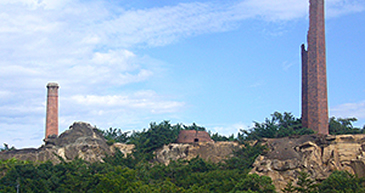 |
|
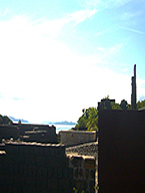 |
|
|
|
| The surreal ruins of the Inujima copper refinery dominate the island. |
|
Architect Hiroshi Sambuichi designed this maze of walls, built with black slag bricks found on the site. |
What do Yukio Mishima and a late-Meiji-era copper refinery have in common? I sure don't know either, but artist Yukinori Yanagi has attempted to establish what seems like a rather tenuous connection between the two in his massive installation on the little island of Inujima, just off the Setouchi coast of the Seto Inland Sea in Okayama Prefecture.
Like many formerly bucolic locales in agrarian Japan, Inujima was sacrificed on the altar of modernization during the country's frenetic, late-to-the-gate version of the Industrial Revolution. Built in 1909, the refinery occupied a sizable chunk of the island and employed 3,000 workers -- but only ten years later a plunge in the price of copper put it out of business. The workers went home, the plant was abandoned, and until very recently all that remained was a population of about 50 and a few very tall smokestacks standing surreal sentinel over a rubble of brick and slag.
Enter Benesse Corporation, mentioned frequently on these pages for its artification of vast swathes of the Japanese landscape -- particularly the islands of the Setouchi area, now dotted with state-of-the-art museums and big outdoor sculptures. The sheer scale and quantity of these projects makes them a bit daunting to contemplate, let alone visit within a limited time frame, but Inujima offers one of the more imaginative, and historically relevant, revitalizations of a local landmark that one is likely to encounter anywhere.
Yanagi has addressed the dilemmas faced by postwar Japan before, often casting a gimlet eye on its failure to come to terms with its imperialist past. While not sharing Mishima's notoriously ultrapatriotic sentiments, he admits to empathizing with the late author's concern for Japan's future after a century of unbridled economic development and Westernization. This is his rationale, in any case, for making the Inujima installation as much about Mishima as it is about industrial pollution and community revitalization.
Yanagi's initial interest in the Inujima site, which he first visited in 1995, stems, he says, from his own infatuation with the beauty of the Seto Inland Sea, and his shock upon learning that the abandoned refinery was slated to become an industrial waste dump. Already acquainted with Benesse eminence-grise Soichiro Fukutake and his ambitious art project on the nearby island of Naoshima, Yanagi proposed that the refinery be purchased and converted into an art installation. Fukutake concurred, acquired the site in 2001, and brought in architect Hiroshi Sambuichi to work with Yanagi on the conversion of the refinery into a museum. After several years of planning and frequent revisions, construction began in 2006 and was completed in 2008.
Serendipitously (for Yanagi, at least), Fukutake had in the meantime purchased the house in Shibuya, Tokyo where the young Mishima lived during the war years. Thus was set the stage for Inujima's curious "collage" (as Yanagi terms it) of Mishima's thought and Japan's industrial legacy.
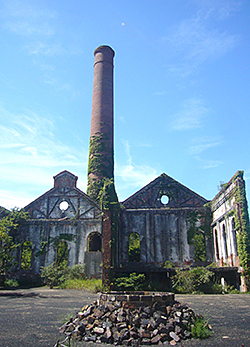 |
|
 |
|
|
|
| The walls of the copper refinery's power plant, with one of the site's chimneys towering behind. |
|
The glass roof of the Seirensho Museum, overlooking the slag-wall maze and the Seto Inland Sea. |
Set amid the decapitated chimneys of the refinery on high ground above the sea, the museum consists of several components. One first enters a nearly pitch-dark labyrinth that snakes through a windowless, pyramid-like structure. Mirrors arranged at 45-degree angles at each turn iteratively reflect a huge, orange solar orb at one end, and a square patch of sky at the other. The sun is a recurring motif, conjuring up both Japan's national flag and Mishima's poem "Icarus." Emerging from the maze, one comes face to face with an installation, under a glass atrium, of doors and windows suspended in midair -- items retrieved from Mishima's dismantled home. Beyond this bright space soars one of the refinery's two intact chimneys, a majestic cylinder of red brick. The chimney's updraft draws air through the length of the labyrinth, naturally moderating the temperature inside the building so that no heating or cooling equipment is required -- an ecological solution that was Sambuichi's brainchild.
Perhaps to deflect impressions that this "shrine" to Mishima may seem a bit too adulatory, Yanagi has added an irreverent touch: a latrine from the old house, placed Duchamp-style amid an expanse of black slag powder raked in patterns like those of a Zen garden.
The rest of the installation dwells upon Mishima's own fixation with the emperor as a symbol of the nation's glory. A small, dark chamber flanked by fusuma panels from the Mishima home is illuminated by red lettering that quotes from "Voices of the Heroic Dead," a 1966 text that asks, "Why should his Imperial Majesty become human?" When one finally emerges into sunlight, it is to confront the cage-like frame of an eight-mat room, also reassembled from the Mishima house, in which metal cutouts of Japanese text are suspended, mobile-like. The text is that of the author's final manifesto, the speech he delivered in 1970 to Self-Defense Force troops after a failed coup-d'etat attempt, just before he committed ritual suicide. An English translation is provided on a nearby wall.
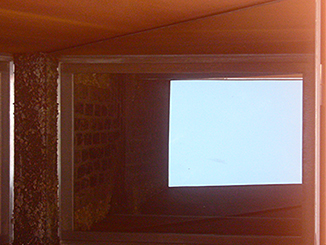 |
|
 |
|
|
|
| Through the adroit placement of mirrors, a skylight in the roof of the Seirensho Museum labyrinth offers visitors an eye-level "light at the end of the tunnel." |
|
Stairs, windows and doorways from Yuko Mishima's family home in Tokyo hang from the Seirensho Museum atrium. In the rear stands the chimney that is the refinery's centerpiece; the opening at the base draws air through the entire museum. Mishima's latrine can be seen on the ground below. |
Perhaps because Yanagi seems determined not to insert his own views into the mix, one is left a bit perplexed by his intentions in filling the installation with all this talk of the emperor and the purported loss of Japan's "national spirit." Personally I was more intrigued by the design of the structure, which Sambuichi has deftly integrated with the remnants of the refinery. He has surrounded the museum with an outdoor maze of walls built from the thousands of slag bricks that were found scattered across the site. Paths lead to stunning vista points overlooking the sea, as well as to the grand, cathedral-like ruins of the complex's brick power plant. And above everything towers the chimney that Sambuichi has put to such effective environmental use as an air-flow conduit.
As is typical of the Fukutake-funded projects on neighboring islands, an attempt has been made to turn all of Inujima into one big art installation. The results are mixed: while some of the new structures (part of the "Art House Project" developed by art director Yuko Hasegawa and architect Kazuyo Sejima) blend into the existing village in novel ways, some simply look weird and out of place. The installation at A-Art House, for example, is a huge acrylic ring filled with garishly colored plastic flower petals. One wonders what the neighbors think. F-Art House, a more traditional structure that reuses the wood from a previous house on the site, fits in better, but is filled with a sprawling, abstract, octopus-like foam sculpture that hardly contributes to the tranquil ambience of the surrounding village.
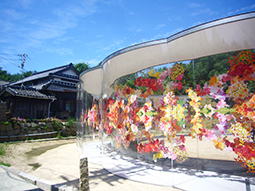 |
|
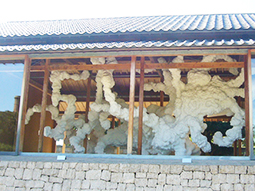 |
|
|
|
| Haruka Kojin's installation reflectwo (2013) at A-Art House, part of the Art House Project in Inujima's village. |
|
Kohei Nawa's foam sculpture Biota (Fauna/Flora) (2013) fills F-Art House.
All photos by Alan Gleason |
The plus side, of course, is that the tourists drawn to these installations bring in badly needed income (the island now boasts several attractive cafes, a lodge, and a campground to accommodate them) and leave what is indisputably a far more benign ecological footprint than did the old refinery. One can only hope that the local citizens do not consider this too much of a Faustian bargain.
Inujima can be reached by boat from neighboring Naoshima or Shodoshima, but the easiest access is from the small mainland harbor of Hoden, only a ten-minute voyage away. Getting to Hoden from the nearest city, Okayama, or the nearest train station, Sakurai, is a bit more problematic, as neither the buses nor the boats run often; it's best to check schedules in advance.